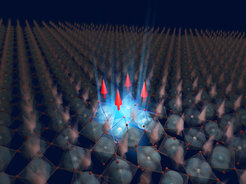Laser pulses triple transition temperature for ferromagnetism in YTiO3
Researchers in Germany and the U.S.A. have shown for the first time that terahertz (THz) light pulses can stabilize ferromagnetism in a crystal at temperatures more than three times its usual transition temperature. As the team reports in Nature, using pulses just hundreds of femtoseconds long (a millionth of a billionth of a second), a ferromagnetic state was induced at high temperature in the rare-earth titanate YTiO3 which persisted for many nanoseconds after the light exposure. Below the equilibrium transition temperature, the laser pulses still strengthened the existing magnetic state, increasing the magnetization up to its theoretical limit.

Using light to control magnetism in solids is a promising platform for future technologies. Today’s computers mainly rely on the flow of electrical charge to process information. Moreover, digital memory storage devices make use of magnetic bits that must be switched external magnetic fields. Both of these aspects limit the speed and energy efficiency of current computing systems. Using light instead to optically switch memory and computing devices could revolutionize processing speeds and efficiency.
YTiO3 is a transition metal oxide that only becomes ferromagnetic, with properties resembling those of a fridge magnet, below 27 K or –246° Celsius. At these low temperatures, the spins of the electrons on the titanium atoms align in a particular direction. It is this collective ordering of the spins which gives the material as a whole a macroscopic magnetization and turns it ferromagnetic. In contrast, at temperatures above 27 K, the individual spins fluctuate randomly so that no ferromagnetism develops.
Using a powerful THz light source developed at the Max Planck Institute for the Structure and Dynamics of Matter (MPSD) in Hamburg, Germany, the team managed to achieve ferromagnetism in YTiO3 up to nearly 100 K (–193° C), far above its normal transition temperature. The light-induced state also persisted for many nanoseconds. The intense light pulse is designed to ‘shake’ the material’s atoms in a coordinated way, allowing the electrons to align their spins.
“The frequencies of the pulses are tuned to drive specific vibrations of the YTiO3 crystal lattice, called phonons,” explains lead author Ankit Disa. “We found that when we excite one particular phonon at its natural frequency of 9 THz, the collective order of the spins and the orbitals of the electrons are modified, leading to a stronger tendency towards a ferromagnetic state. When driving other phonons, we observed totally different results: Excitation of a phonon at 4 THz actually worsens the ferromagnetism and of one at 17 THz enhances it – but not as strongly as the 9 THz phonon does.”
Below the usual transition temperature of 27 K, the 9 THz phonon excitation significantly increased the magnetization, raising it by around 20 per cent to its theoretical maximum – a level that had not been achieved to date.
The THz source used in these experiments delivers intense pulses and is capable of exciting a very narrow frequency region in the material, making it an extremely precise tool. It has already been deployed in several other MPSD-led studies on light-enhanced superconductivity and magnetism. However, this work revealed for the first time that qualitatively different effects can be produced by exciting a range of lattice vibrations.
Apart from deepening scientists’ understanding of intense and ultrafast light-matter interactions, these results are important stepping stones towards the optical control of magnetic components. “This work does not only demonstrate the switching of magnetism on and off on demand, it also gives us a foretaste of what could be done to store and process information at ultra-high speeds,“ explains Andrea Cavalleri, Director of the MPSD’s Condensed Matter Dynamics Department. “Beyond this demonstration, our work underscores the ability to create order in disordered, fluctuating phases of matter, something akin to freezing water with light. Controlling these processes has been a long-standing goal of our group. Over the years we have reported a number of other realizations that flank this work, including photo-induced high temperature superconductivity [1], [2] and photo-induced ferroelectricity [3].”
At Harvard University and the University of California – Los Angeles, postdoc Jon Curtis and his advisor Prineha Narang provided crucial theoretical contributions. In Germany, the collaboration included the groups of Bernhard Keimer at the Max Planck Institute for Solid State Research (Stuttgart) and Andrey Maljuk at the Leibniz Institute for Solid State and Materials Research (Dresden).
[1] D. Fausti, R. I. Tobey, N. Dean, S. Kaiser, A. Dienst, M. C. Hoffmann, S. Pyon, T. Takayama, H. Takagi, and A. Cavalleri, Light induced Superconductivity in a Stripe-ordered Cuprate, Science 331 (6014) 189–191 (2011), DOI: 10.1126/science.1197294
[2] M. Mitrano, A. Cantaluppi, D. Nicoletti, S. Kaiser, A. Perucchi, S. Lupi, P. Di Pietro, D. Pontiroli, M. Riccò, S. R. Clark, D. Jaksch, and A. Cavalleri, Possible light-induced superconductivity in K3C60 at high temperature, Nature 530 (7591), 461–464 (2016), DOI: 10.1038/nature16522
[3] T. F. Nova, A. Disa, M. Fechner, and A. Cavalleri, Metastable ferroelectricity in optically strained SrTiO3, Science 364 (6445), 1075–1079 (2019), DOI: 10.1126/science.aaw4911












